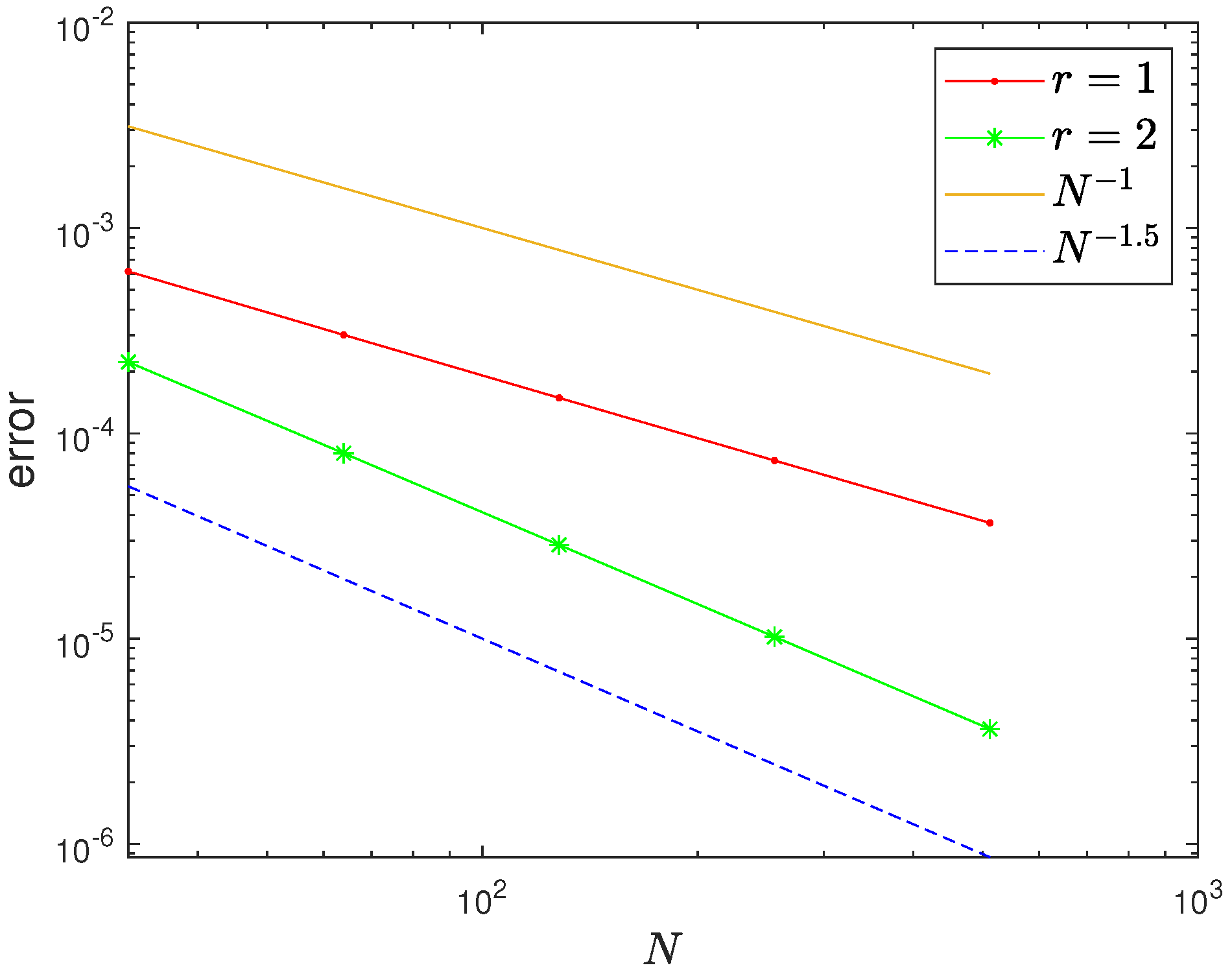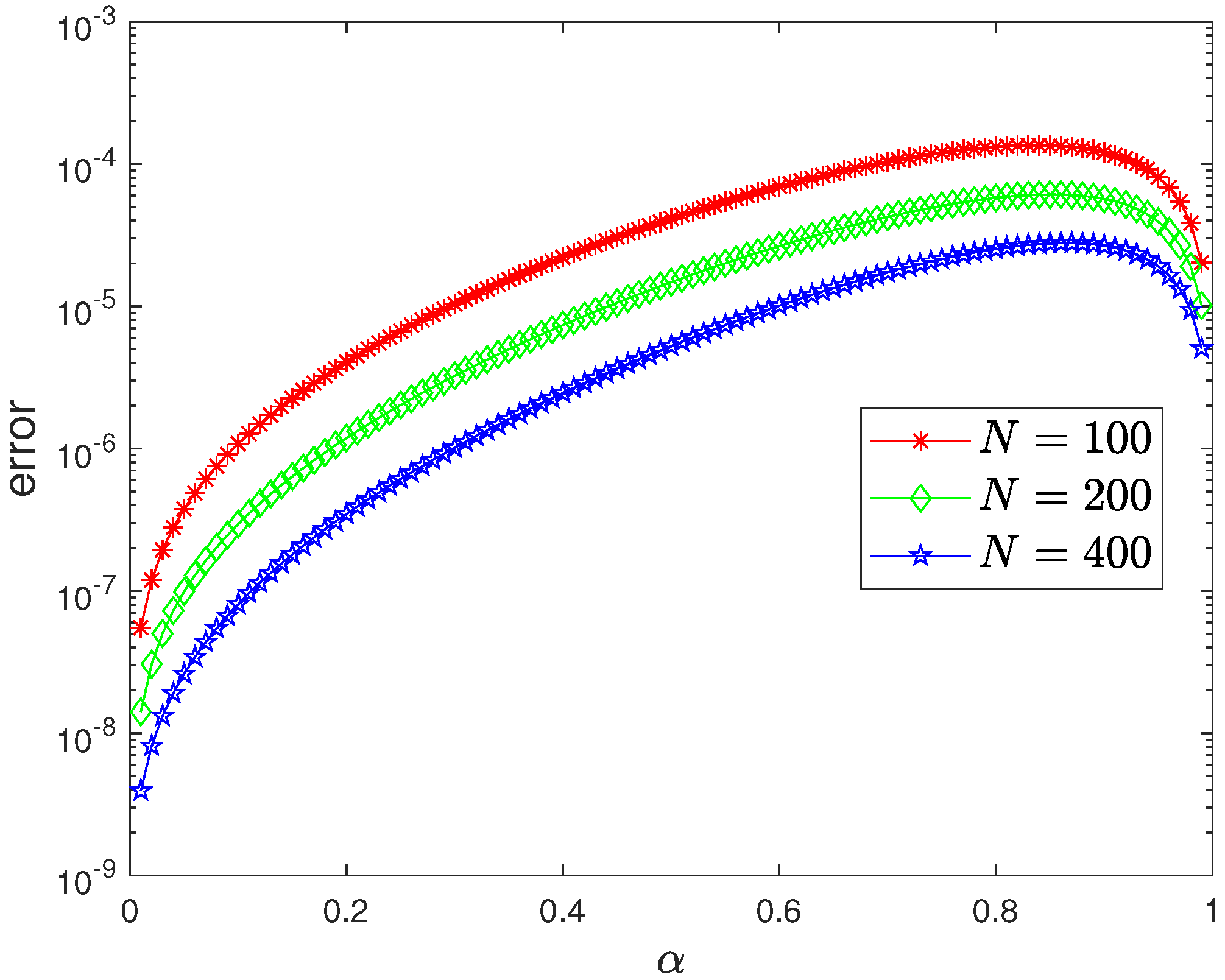1. Introduction
Black–Scholes equation (BSE) was first proposed by Black and Scholes [
1] and Merton [
2], which has wide applications in finance, such as options in derivatives, etc. The option price derived by the BSE model is under the assumption that the underlying asset follows the geometric Brownian motion and has constant volatility; thus, it fails to capture the significant movements or jumps over small time steps in a financial market [
3].
In recent years, fractional differential equations (FDEs) have attracted extensive interest among researchers all over the world. Stynes et al. [
4] first conducted an error analysis of the L1 scheme on graded mesh for a time-fractional diffusion equation with weakly singular solutions. Liao et al. [
5] considered the L1 scheme on a general nonuniform mesh for a reaction-subdiffusion equation, and the convergence analysis is based on a discrete Gronwall inequality. Kopteva and Meng [
6] established pointwise-in-time error estimates of the L1 scheme and Alikhanov’s scheme for the time-fractional diffusion equation, and later the analysis was extended to the L2 scheme in work [
7]. Jin et al. [
8] gave an extensive literature review on numerical methods for time-fractional evolution equations with nonsmooth data. In a series of papers, Yang and Zhang [
9,
10,
11] investigated the convergence of the collocation method and finite volume method for subdiffusion equations. For the numerical approximation and analysis of quasilinear subdiffusion equations, we have noted two recent papers; see [
12,
13]. As FDEs involve the fractional derivatives, which have the properties of non-locality and long memory; thus, FDE-based models are proposed in the financial field. The following time-fractional BSE was proposed in [
14]:
subject to terminal condition
and boundary conditions
where
is the volatility of the underlying asset,
,
r is the risk-free interest rate,
T is the maturity date of the European option, and
denotes the modified right Riemann–Liouville derivative which is defined by the following:
Let
,
, and
, assume
, after transformation, the model (
1)–(
3) can be rewritten as the following initial-boundary value problem [
15]:
where
is the Gerasimov-Caputo derivative of order
with respect to
t. It is defined as follows:
To numerically solve the option price problem, usually the unbounded spatial domain is truncated into a bounded domain
, where in practice,
is large enough so that the truncated boundary in the price scale
S is three to four times the strike price [
16]. Without loss of generality, in this paper, we consider the following model problem:
where
a,
b, and
c are constants satisfying
and
;
; and
f is a continuous function.
Zhang et al. [
15] proposed a finite difference method for the model problem (8)–(10), but the error analysis is under sufficient solution regularity, while it is well-known that the solution typically exhibits some weak initial singularity for the time-fractional derivative problem [
17]. Hence, the aim of this paper is to provide a detailed error analysis under the realistic assumption that the solution has weakly singular solutions. It should be noted that, recently, some papers have taken the weak singularity under consideration, such as [
18,
19,
20]. The work [
18] proposed a compact difference method for time-fractional BSE, and ref. [
19] proposed two higher-order compact difference methods for time-fractional BSE; both of the two works used the L1 scheme for the discretization of the time-fractional derivative. The work [
20] proposed a fast scheme with variable time steps for the time-fractional BSE, where they used Alikhanov’s scheme for approximation of the time-fractional derivative.
The main contributions of this paper are as follows:
We employ the L1 scheme on a graded mesh to compensate for the weak singularity at initial time.
A discrete comparison principle is established for the fully discrete scheme.
Stability and convergence of the fully discrete scheme in maximum norm are presented by constructing some barrier functions.
An -robust pointwise error estimate of the fully discrete scheme on a uniform mesh is established.
The paper is outlined as follows: In
Section 2, we construct a finite difference scheme for the problem (8)–(10). A discrete comparison principle of the fully discrete scheme is given in
Section 3, and based on it the stability of the fully discrete scheme is presented in
Section 4 by constructing some appropriate barrier functions. The convergence of the fully discrete scheme in maximum norm is proved in
Section 5.
Section 6 is devoted to giving an
-robust pointwise error estimate of the scheme on a uniform mesh. Some numerical results are presented in
Section 7. Finally, the paper ends with a conclusion in
Section 8.
Notation: Throughout the work, C denotes a generic constant, it may have different values in various contexts, but it is always independent of the mesh sizes.
2. A Finite Difference Scheme
Given two positive integers M and N, we partition the space and time intervals and into M and N parts, respectively, with the mesh points and . In this paper, we choose for with spatial step size and for , with as the grading parameter which can be chosen by the user. We designate for . We denote as the approximation of the exact solution for all admissible i and n.
For discretizations of the spatial derivatives
and
, we use the well-known second-order central difference formulas, viz., calculated as follows:
and
For the approximation of the Gerasimov-Caputo fractional derivative
, a widely used method is the L1 scheme, which uses piecewise linear interpolation to approximate the solution (see the review article [
21] for more details), written as follows:
where
Note that
, and one can easily verify the following:
by the mean value theorem.
Now we have the following discrete problem to approximate the continuous problem (8)–(10):
6. -Robust Pointwise Error Estimate on Uniform Mesh
One can see that there is a constant
C in Lemma 4, which is based on the analysis of [
6]. However, if one carefully checks the proof of ([
6], Theorem 2.1), one can see that the constant
C in Lemma 4 contains the factor
, which will blow up when
. In this section, we give an
-robust pointwise error estimate on a uniform mesh. We call the constant
C -robust if it does not blow up when
.
Now on uniform mesh, with the time step
, the L1 scheme becomes the following:
where
Note that
and
on uniform mesh. Now the stability multipliers becomes the following:
Note here
on uniform mesh. One can easily see that the definition of
is the same as ([
26], Equation (4.6)). Then we have the following:
Lemma 5 ([
26], Lemma 2)
. For , one has the following: Given a positive integer
n for
, we define the following:
It is easy to verify that
is strictly decreasing for the variable
and
.
By Lemma 5, from ([
27], Lemma 9), we have the following:
Lemma 6. Let . For , one has the following: On uniform mesh, i.e., , from Lemma 3, the truncation error of L1 scheme is . Then we have the following lemma:
Lemma 7. Let . For , one has the following:where C is α-robust. Proof. Note that
, by Lemma 6, we obtain the following:
where we have used
to deduce the last inequality. Finally, noting that
and
, the desired result follows. □
Theorem 4. Let . For the errors on uniform mesh, one has the following:where C is α-robust. Proof. Following the proof of Theorem 3, substituting Lemma 7 into (
18), one obtains the desired result. □
7. Numerical Experiments
Example 1. Let , , , , . Suppose the problem (8)–(10)
has an exact solution, written as follows:which exhibits a typical weak singularity at the initial time. The function f can be computed by (8)
. We define
as global errors and
as local errors. As the spatial accuracy is well-known, here we just show the convergence in the time direction. To test the temporal accuracy, we take
to eliminate the contamination of the spatial errors.
Table 1,
Table 2,
Table 3,
Table 4,
Table 5 and
Table 6 show the convergence orders of the global errors and local errors; one can see the convergence order of the global error is
, while the local error can attain the optimal convergence order
under milder grading parameters (e.g., one just takes
). This is consistent with Theorem 3.
Table 7 presents the comparison of the computational cost of the numerical scheme between the case
and the case
, where we take
and
to compute the local error of our scheme. From which one can see that the CPU times are comparable between the uniform mesh
and graded mesh
, but the latter attains higher convergence rates.
Figure 1 shows the convergence rates in the case
for uniform mesh
and graded mesh
, and it is clear that the case
has a higher convergence rate.
In
Table 4, it is interesting to see that the local errors increase as
increases, so we test the local errors for various
between
, and the results are presented in
Figure 2. From this figure, we can see that the errors increase when
increases (this is natural as the convergence rates worsen as
increases), but when
approaches
, the errors then decrease (at present we do not know why).
Example 2. Let , , , , , the function , the initial condition .
Since the exact solution to Example 2 is unknown, we use the two-mesh principle in [
28] to estimate the convergence rates of our computed solutions. The local differences
of the two-mesh are defined by the following:
where
with
is computed on a second temporal mesh
with the same mesh of
in space. The estimate convergence rates are computed by the following:
We also take
to eliminate the contamination of the spatial errors.
Table 8,
Table 9 and
Table 10 present the two-mesh differences and convergence orders for Example 2 with difference choice of
r, which agrees with our theoretical prediction, i.e., just choosing
, the optimal convergence order
is obtained.








